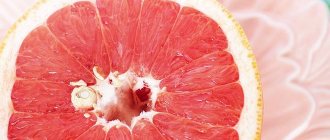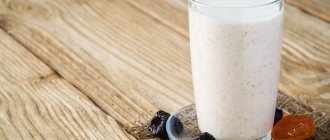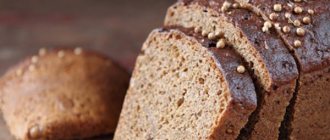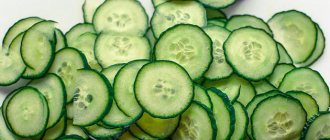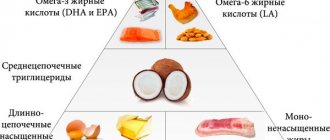General information
The drink is prepared from skim or whole milk by alcoholic or fermented milk fermentation using special fungi.
Sourdough contains about 20 organisms, including streptococci, lactobacilli, acetic acid bacteria and yeast. Now the food industry also offers a type of drink called biokefir. During its production, special starter preparations are added to the product. They contain acidophilus bacilli and bifidobacteria, which do not dissolve under the action of gastric juice, but directly enter the intestines. Being a natural component of its microflora, they inhibit the activity of pathogenic bacteria.
Kefir has probiotic properties - it has a beneficial effect on the gastrointestinal tract and improves metabolism.
The nutritional value
For a classic drink with a fat content of 2.5%, it is 53 kcal per 100 g of product.
The ratio of proteins, fats and carbohydrates is 2.9 g, 2.5 g and 4 g, respectively. Amount of water – 89 g. Kefir contains:
- vitamins H, PP, A, C and group B;
- minerals – calcium, phosphorus, cobalt, molybdenum, iodine, potassium, chlorine, sodium, etc.
Vitamins and minerals contained in kefir.
Best lists
Today’s review includes only 1% natural kefir - this is according to the labeling and microbiological analysis of a well-known quality control organization in Russia. You can learn about the taste properties of each product from personal experience or from customer reviews, but this criterion is always subjective. We have selected 3 brands of fermented milk drink that deserve special mention.
The best kefir 1% according to experts
The BioMax brand is produced by Wimm-Bill-Dann. Its line includes kefir and kefir drinks with all kinds of fillings. To make kefir, only whole milk and live starter are used, which makes it healthy. Laboratory studies did not reveal the presence of non-dairy fats, starch, or preservatives.
The product has earned a high health index; it is also enriched with vitamins A, E, D, H and folic acid at the level of 7-20% of the daily value per 100 g. Due to its properties (acidity), the product can be recommended for dietary nutrition. Meanwhile, the protein content does not correspond to that indicated in the labeling, exceeding the specified level by more than 10%. However, the nutritional value of a product with such indicators is considered higher.
The best kefir 1% according to customers
The absolute leader in popularity among consumers as of 2021 is kefir under the Prostokvashino brand. It is moderately thick, soft, pleasant to the taste and not sour. The consistency is homogeneous without lumps. It does not cause unpleasant bloating in the intestines, as sometimes happens when taking kefir from other manufacturers.
A classic version of a low-fat fermented milk drink with a natural composition and excellent taste at an affordable price, plus trust in a well-known manufacturer - all this makes this product so in demand. It is also worth noting compliance with GOST requirements during manufacturing, which was confirmed by the results of the examination of the Roskontrol organization.
The best kefir 1% with a short shelf life
Kefir 1% “Kozelskiy” is produced using normalized pasteurized milk and live kefir grains, from which the starter is made. Lactic acid microorganisms contain – 107 CFU/g, and yeast – 104 CFU/g. Protein, as expected, is 2.8-3 g. Users in numerous reviews emphasize that the drink has a creamy natural taste without pronounced acidity.
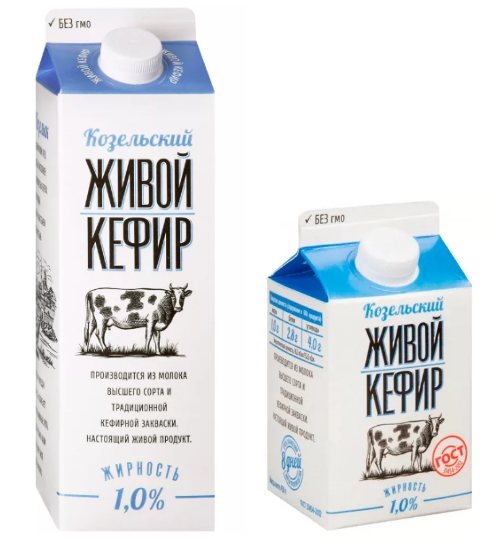
The consistency is homogeneous and medium in thickness. There are no lumps, but only moderate bubbles, which indicates high quality. Many also liked the convenient packaging, which they can take with them on the road and drink on the go at any time. To do this, the box has a twist-off lid located at an angle.
Differences between adult and children's kefir
A children's drink differs from an adult drink in having less acidity and fat content.
Classic kefir can cause vomiting or indigestion in a child. The baby’s body is not yet able to cope with sour foods, so the baby drink is made to have a milder taste. In addition, a child under 3 years of age has not yet developed enzymes that help digest high-fat foods. For the production of children's kefir, only the highest grade milk is used, while the first grade is suitable for adult products.
Nutritionists recommend introducing the classic drink into a child’s diet only from the 3rd year of life.
The benefits of kefir for children
The product has a beneficial effect on the children's body:
- restores intestinal microflora;
- prevents gastrointestinal diseases;
- supplies the body with essential vitamins and minerals;
- strengthens the immune system;
- improves appetite;
- helps with sleep disorders.
According to research, a child’s digestive system absorbs protein from kefir better than from milk.

The beneficial effects of kefir on the child’s body.
Indications for use
Pediatricians recommend drinking the drink for children who suffer from intestinal dysbiosis, constipation, anemia, rickets, and immunodeficiency pathologies. It is able to provide the body with calcium necessary for the growth of the baby’s bones. It is believed that in cases of lactose intolerance, kefir can replace milk in a child’s diet.
Taking fermented milk products for therapeutic purposes should be discussed with your doctor.
Contraindications
Despite all its wonderful properties, kefir, meanwhile, has a number of contraindications. So, people suffering from diseases of the gastrointestinal tract with high acidity of gastric juice should not drink the drink. Particular care should be taken when consuming kefir in case of hyperacid gastritis and pancreatitis.
You should not consume kefir before exams, important meetings and events, or if you are going to drive. One of the properties of this drink is relaxing, which under certain circumstances can create trouble.
When and how to introduce kefir into the diet
Kefir is introduced into the baby's diet gradually.
With artificial feeding, it can be fed to a 7-month-old baby. The first time the child is given a teaspoon of the drink to try. With natural nutrition, complementary feeding with kefir begins a month later. Kefir should not be given to a child at night. Parents should monitor the child’s body’s reaction to new food. If a child develops allergies, problems with the gastrointestinal tract, or shortness of breath, you should stop taking kefir. If you experience the last symptom, you should immediately consult a doctor.
If there were no negative reactions, you can continue to get acquainted with the product the next day.
It must be remembered that the drink contains calcium, and if the crown becomes overgrown at a rapid pace, complementary feeding should be postponed until the age of one year.

Kefir is introduced into baby's complementary foods gradually, starting with a teaspoon.
Consumption standards
Starting with a teaspoon per day, the amount of kefir is gradually increased to 100 ml for babies aged 9–10 months.
By the age of one year, the volume of drink consumed can reach 200 ml per day. After the first 12 months of life, other dairy products appear in the child’s diet - cheeses, cottage cheese and sour cream. Therefore, for up to 3 years, the amount of kefir consumed per day remains at the same level - 200 ml.
Kefir recipes
Kefir can be prepared at home.
This allows you to control the quality of the ingredients and the fermented milk product itself. The main components are milk and a special starter, which is sold in pharmacies. In home recipes, the latter is often replaced with sour cream or a ready-made drink.
With cow's milk
Ingredients:
- milk – 1 l;
- sourdough – 1 tbsp. l.
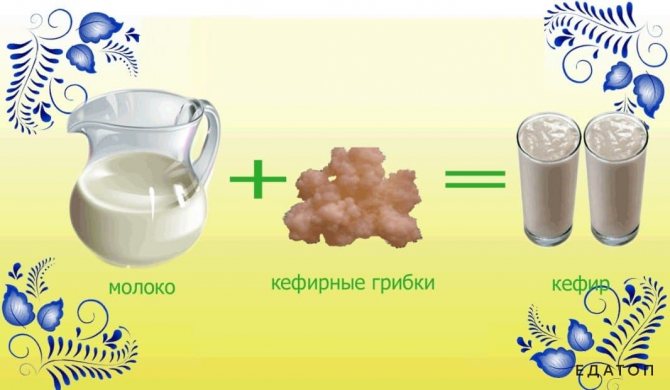
Recipe for making homemade kefir with cow's milk.
Cooking steps:
- The milk is boiled and allowed to cool to a temperature slightly above room temperature.
- Add the starter and, covering the mass with gauze or cloth, put it in a warm place, protected from direct sunlight. Do not use a lid to prevent the fungus from suffocating and dying.
- After 10 hours, the contents of the jar are stirred.
- After a day, if the milk has thickened, the product is ready. It is filtered and poured into a container for storage.
Instead of sourdough with fungus, you can use 50 ml of ready-made homemade kefir.
With sour cream sourdough
Ingredients:
- milk – 500 ml;
- sour cream – 2 tbsp. l.
Cooking sequence:
- The milk is boiled, allowed to cool, and poured into a glass container.
- Separately prepare the starter. Mix sour cream and 50 ml of milk thoroughly and pour the mixture into a jar.
- The container is removed for 24 hours in a warm place.
After a day, the product is ready for use. It should be stored in the refrigerator.
Application
Kefir is beneficial for the human body only when consumed correctly. So, it should be at normal room temperature; cold or warm kefir should not be consumed. Before drinking a glass of this lactic acid product, let it sit at room temperature. They drink it in small sips, taking pauses. In large doses, kefir can overload the stomach.
Kefir is widely used in cooking, in particular for baking.
Market Analytics
- 2020: an unprecedented test for the global cosmetics industry
- Top 10 Cosmetic Research and Development of 2021
- 2020 in the beauty industry – innovation without borders
Convenient search for beauty salons on our website
Beauty salons in Moscow Beauty salons in St. Petersburg Beauty salons in Ekaterinburg Beauty salons in Novosibirsk
Latest blog posts on our website
- Naturecream / Esterified oils
- Naturecream / Arnica - the magical plant of alchemists
- Naturecream / Tremella Extract - Snow Mushroom Detox for Skin
- Prostye-sovety / How to visually enlarge your lips with makeup
- Naturecream / Apricot kernel oil for face
- Naturecream / MATRIXYL3000 - the best skin elasticity stimulator
- Naturecream / SPF in Natural Oils
- Naturecream / Geranium (Pelargonium) oil for skin health and beauty
- Prostye-sovety / Save on a beauty salon: procedures that can be done at home
- Naturecream / Growth Factor - brings back youth?
Latest forum topics on our website
- Natalya / How to properly make a gelatin mask?
- Mrs._Smith / Badly sunburned! What to do?((
- Ice / Is it necessary to combine fitness classes with a diet?
- Antonova / What can be used for hair loss?
- Radio operatorKat / Who was on a protein diet?
Other articles in this section
| Mascarpone Cheese Mascarpone is a soft cheese. Italy is considered its homeland. The raw material for it is selected cream, which is skimmed from cows' milk. Mascarpone cheese is quite fatty, its structure is creamy. Its taste is similar to homemade sour cream, it is slightly sweet, rich and very pleasant. |
| Manchego cheese Manchego cheese is a Spanish cheese made from pasteurized sheep's milk. The birthplace of this product is the La Mancha region of Spain. Manchego cheese matures over a period of three to six months and has a fairly firm texture, rich aroma and golden color. There are small holes in the cheese pulp. |
| Gruyere Cheese Gruyere cheese is the highest grade of cheese produced in Switzerland. This tasty and delicate cheese is made in the western part of the country, where the alpine meadows are located. The history of its production goes back to the distant 17th century, it was then that it received its name in honor of the town at the foot of the Alps. Gruyère is a hard cheese, slightly fattier than Parmesan. It is brewed from evening milk, left to settle and a little fresh added. The milk is then curdled and pressed. The result is a very delicate cheese, homogeneous when cut. Gruyère is produced from June to September and matures for 4 to 8 months. Only cheese made in certain cantons of Switzerland can be called Gruyère; even if the entire technological process in other regions is followed, the cheese can no longer bear the name Gruyère. |
| Rokiskio cheese Currently, in the post-Soviet space, among the Baltic republics, namely in Lithuania, in the city of Rokiskis, a wonderful Rokiskio cheese is produced that has long gained popularity. |
| Kefir, 2% This fermented milk product is made from milk by adding special “kefir” grains to it. Karachais first began producing this drink in the middle of the 19th century. At the same time, they carefully hid the technology for making the unique drink. |
| Cottage cheese 1.8% (low-fat) The history of the appearance of cottage cheese is lost due to an incredible amount of time ago. Humanity has been eating it since the time when milk-producing animals were first domesticated. Among the Slavic peoples and in Ancient Rome, cottage cheese was very widespread and was present in almost the daily diet. Nowadays, it is used in cooking all over the world. |
| Sour cream 20% (medium fat content) Sour cream is one of the most popular dairy products today. This product was actively consumed by our ancestors, but modern production technologies make it possible to make it not only tasty, but also very healthy. |
| Processed chocolate cheese Processed chocolate cheese is a dairy product that is made from rennet cheeses and cottage cheese with the addition of cocoa and other ingredients. The melting point of cheese is usually about 75-95 degrees. |
| Tilsiter Cheese Tilsiter Cheese is a semi-hard, round, flat cheese made from cow's milk, which has a unique, inimitable taste and smell of cumin and black pepper. The cheese has a yellow color, cracks, small holes and a brown crust. The birthplace of the cheese is the town of Tilser in East Prussia. Its recipe was invented by immigrants from the Swiss province of Bern. The production of cheese in large quantities for other countries only began in the 19th century. This species has won the special trust and love of gourmets. This is an excellent treat for raw foodists. |
| Acidophilus 0.1% Acidophilus 0.1% is a fermented milk product that is obtained by mowing milk. For starters, use kefir sticks or acidophilus starter. This is a relatively new product and has not yet been appreciated, but Acidophilus 0.1% has already found its fans. The product comes in varying degrees of fat content, depending on the milk being fermented. |
Tips and tricks
Kefir can be given every day, but pediatricians and nutritionists recommend using it in the diet 2-3 times a week.
You should switch to evening feeding with a drink only after the child gets used to it. The product can be fed from a spoon or from a small cup.
You should not adhere to strict calendar schedules when introducing kefir into your child’s diet. If the baby’s body reacts negatively to the drink, there is nothing to worry about if its consumption is delayed for several months.
